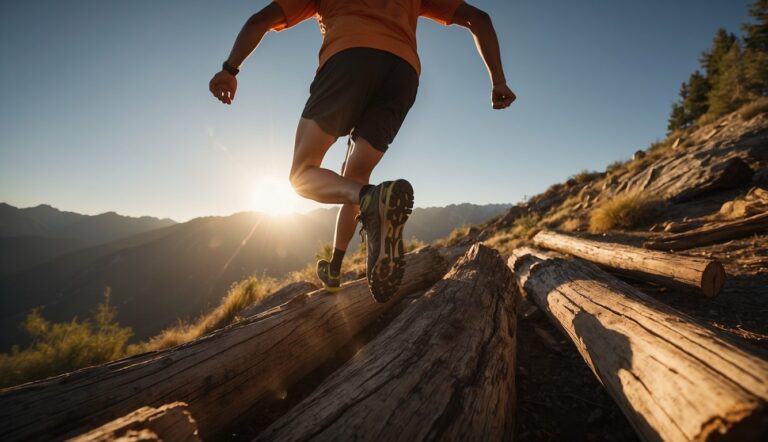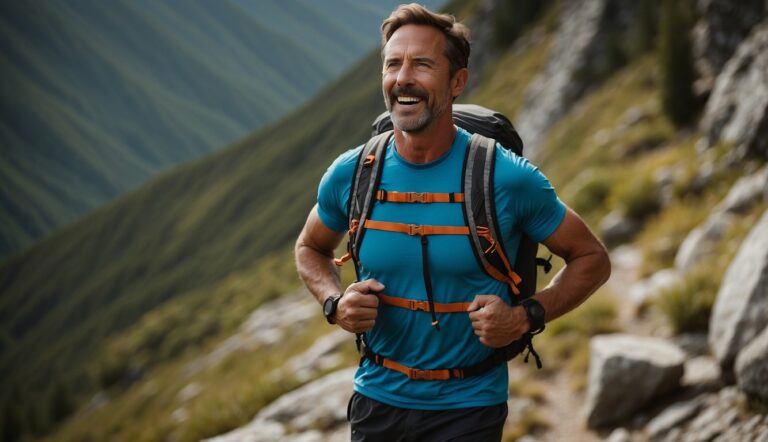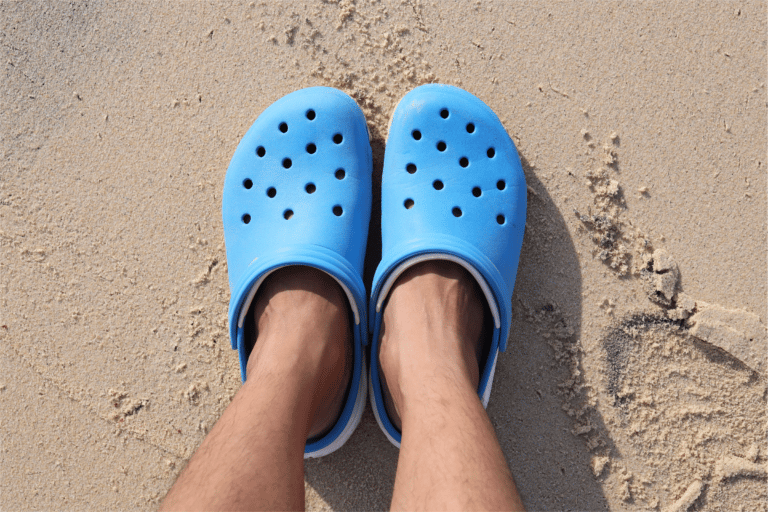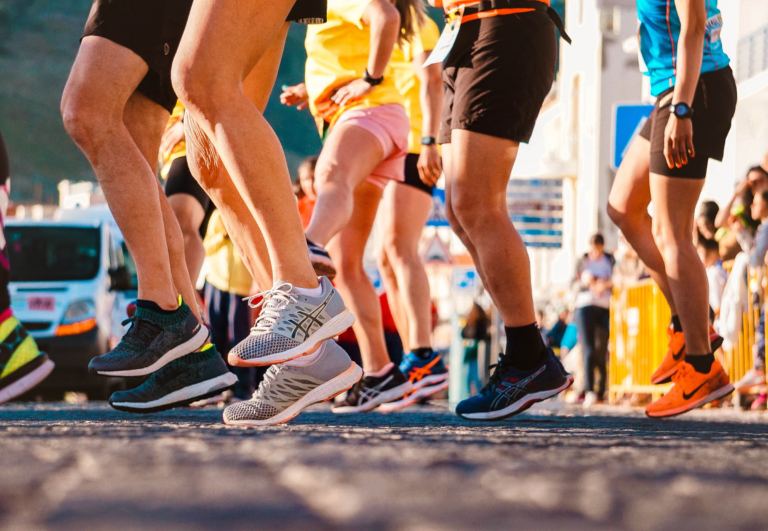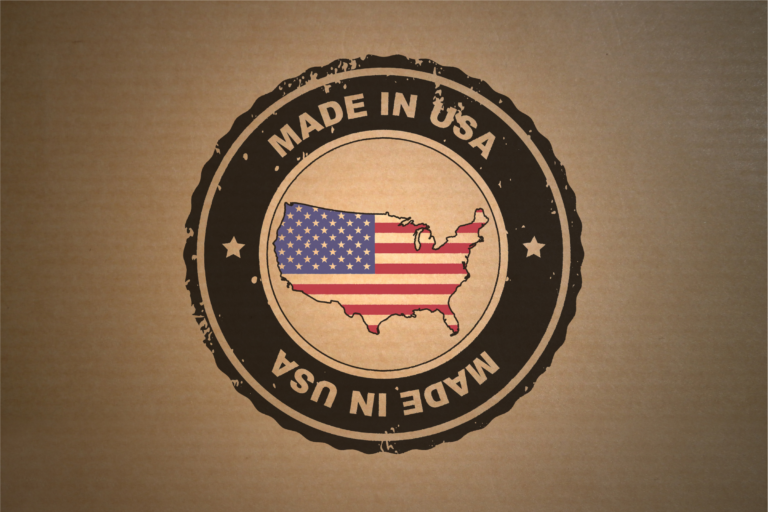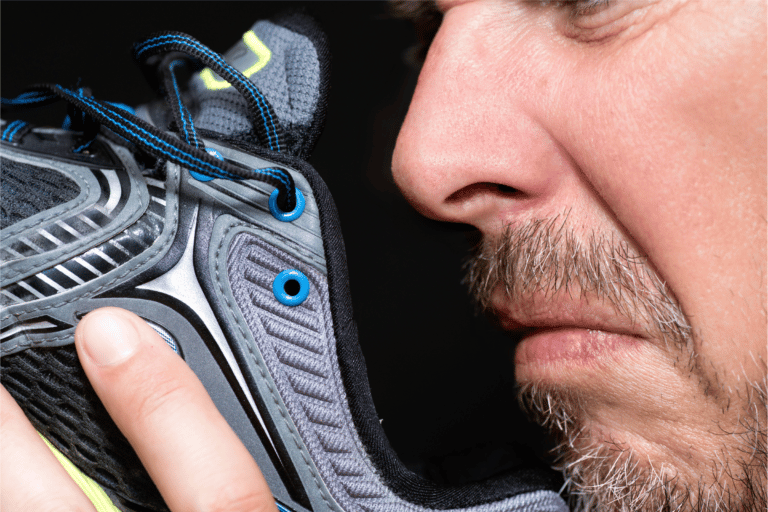What to Look for in Trail Running Shoes as a Beginner
As a beginner, selecting the right pair of trail running shoes can be pivotal in providing the grip, support, and protection your body needs to tackle uneven surfaces confidently. These shoes, usually having a minimum of 4mm lugs, cater to the varying outdoor terrains: muddy tracks, rocky paths, amongst others. It’s an exciting category in any sports store and making the choice of shoes is the crucial first step in your trail running adventure.
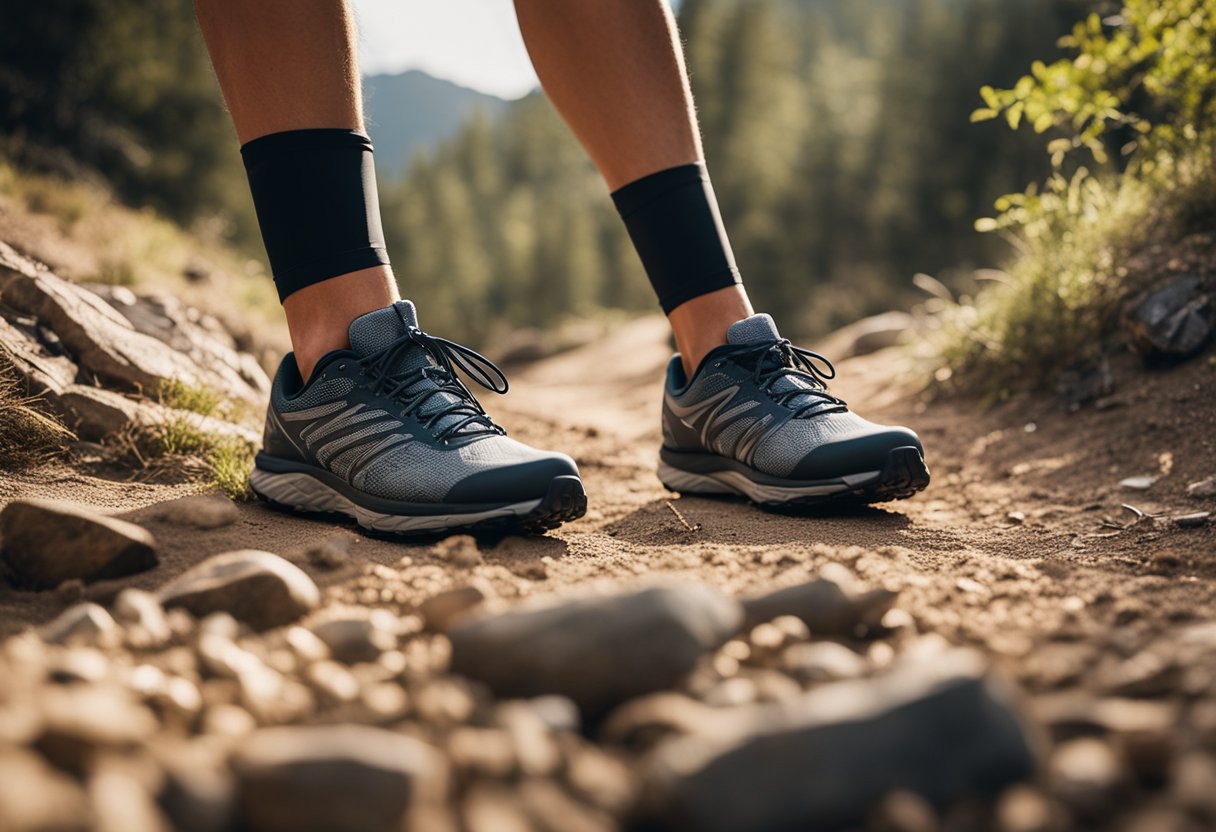
When looking for your first pair of trail running shoes, focus on traction, foot protection, and stability. Shoes with enhanced traction will, for example, help your legs maintain their footing in slippery conditions, whereas added foot protection shields your feet against the inevitable encounters with roots and rocks. Stability in your shoes is key to keeping you safe and comfortable over the miles as you navigate the unpredictable outdoor elements.
Lastly, consider the shoe’s fit and comfort level, which are especially important when you are covering longer distances off the roads. Your trail running shoes should offer enough length, size, and space for your toes to move freely while ensuring a secure fit to prevent blisters and unwanted movement that can lead to injuries. When perusing the store for your perfect pair, keep these factors in mind.
In this article, we’ll cover all the information you need to make the right choice for your transition to trail running shoes!
Trail Running Shoes – What Makes Them Special?
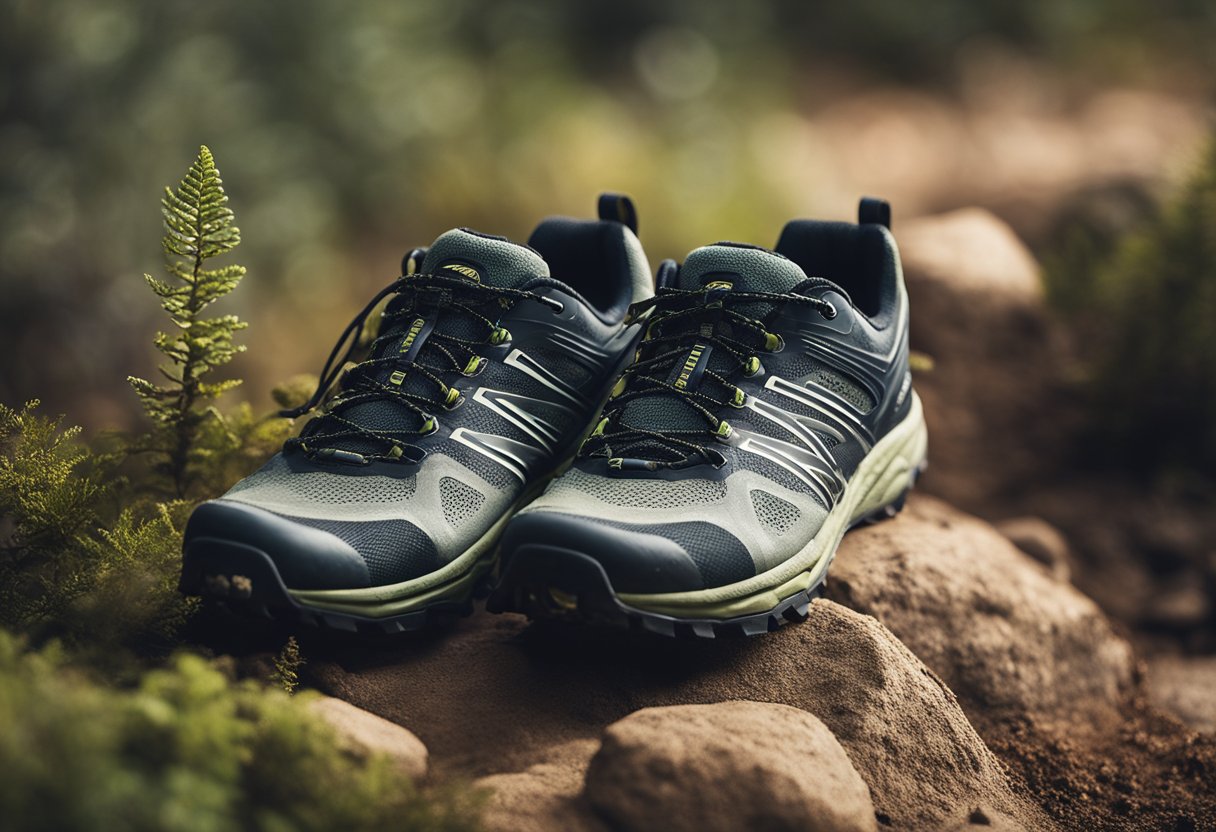
Versatile trail shoes have some special characteristics that are key to ensuring your safety and enjoyment as you navigate trails that vary significantly from paved surfaces.
Trail Running Essentials
When you embark on a trail run, your shoes should offer a balance of traction, stability, and protection to tackle the varied ground underfoot.
Look for:
- Traction: Lugged soles for grip on dirt, mud, and rocks.
- Protection: Toe guards and reinforced materials to withstand abrasion.
- Stability: A solid platform that helps prevent twists and turns on uneven surfaces.
Trail Running vs Pavement
Comparing trail runners to pavement running shoes highlights significant differences:
| Feature | Trail Running Shoes | Pavement Running Shoes |
|---|---|---|
| Sole | Lugged for diverse terrain | Smooth for flat surfaces |
| Protection | Reinforced against rough elements | Lighter material for speed |
| Construction | Durable for longevity | More focus on responsiveness |
While road running shoes prioritize speed and responsiveness, trail running shoes fall in a different category as they are designed to offer security and durability on a technical surface. Take note of these differences when planning your gear list.
Trail running presents an adventure beyond the uniformity of pavement, where every step tests your agility and needs attention. Your shoes serve as the foundation for this dynamic experience, making them a specialized piece of your trail running gear puzzle.
Choosing the Right Trail Shoes
The right pair of trail running shoes will enhance your running experience by ensuring fit, comfort, and protection. You don’t want to be out on a mountain trying to run in sneakers, sandals, or heavy boots.
Let’s look at some tips for selecting your ideal trail running shoes. Here is our advice:
Types of Trail Running Shoes
When venturing into trail running, it’s important to match your shoes to the terrain:
- Light trail shoes are suited for well-maintained paths and offer a balance between flexibility and protection.
- Rugged trail shoes provide extra protection, structure, and support for uneven and challenging trails.
- Minimalist shoes offer a barefoot-like experience and are designed for those who prefer a natural feel with less cushion.
- Maximalist shoes have considerable cushioning and are designed for long distances, providing comfort and impact absorption.
Shoe Fit and Comfort
A well-fitted trail shoe should feel snug but not tight, with room for your toes to splay:
- Toe box: Ensure there’s enough width to prevent blisters and allow for swelling on long runs. Sizing is key here – consider moving up a shoe size if necessary.
- Heel: Your heel should fit securely with minimal slippage. Use proper lacing to lock in the heel.
- Midfoot: The shoe should wrap comfortably around the arch and sides of your foot.
| Fit Area | Description |
|---|---|
| Toe Box | Allows toes to move freely |
| Heel | Keeps foot locked in place |
| Midfoot | Snug but comfortable support |
In addition, wear your running socks when trying on shoes to gauge the best fit, as they can influence the shoe’s internal volume.
Understanding Shoe Specifications
Knowing key specifications can help you choose shoes that align with your biomechanics and running style:
- Cushion: The shoe’s ability to absorb impact; more cushion is beneficial for long distances.
- Balance: A shoe’s stability is important, especially on technical trails.
- Protection: Look for features like a rock plate when running on terrain with sharp rocks and roots.
- Stack height: The amount of material between your foot and the ground; affects how much you feel the trail.
- Heel-to-toe drop: The height difference between the heel and forefoot, known as ‘drop,’ can range from zero (flat) to more than 12mm. Consider lower drops for a more natural foot motion.
| Specification | Function |
|---|---|
| Cushion | Impact absorption |
| Protection | Guard against terrain |
| Drop | Heel-to-toe height difference |
Important Features in Trail Shoes
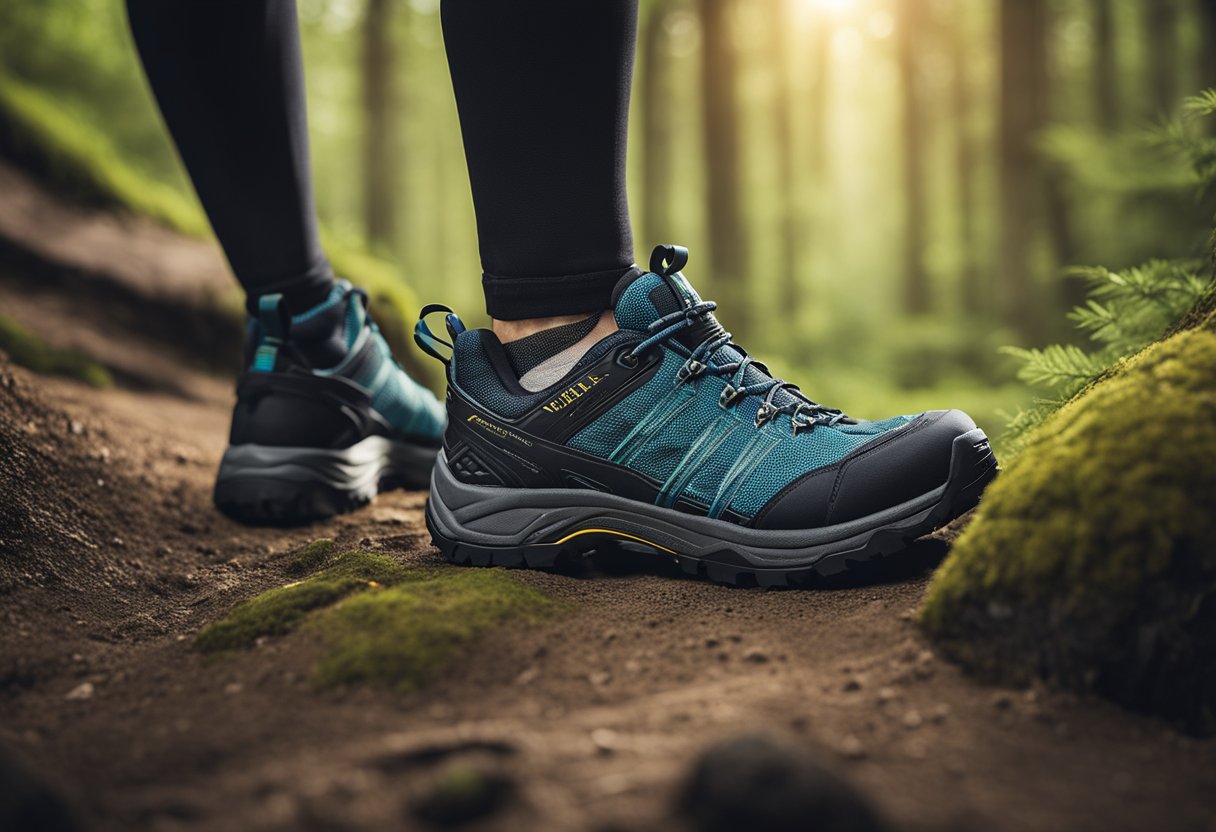
As a seasoned trail runner, I know the importance of finding shoes that match the demands of off-road running. These features are crucial to ensure you have a stable, comfortable, and enjoyable run.
Traction and Grip
When running on trails, you’ll encounter a variety of surfaces on your way from loose dirt or gravel to slippery rocks. Shoes with lugged soles offer better traction to keep your footing stable on these unpredictable terrains.
- Optimal traction: Look for deep lugs that are widely spaced.
- Material: Sticky rubber compounds can enhance grip on wet surfaces. Vibram outsoles are popular on trail shoes for their grippy surface.
Cushioning and Support
Your feet need extra cushioning to handle the impact of uneven surfaces, while support provides stability against the twists and turns of a trail.
- Cushioning: Sufficient padding to absorb shock, yet remain responsive.
- Support: Features like reinforced heel cups for ankle stability. Also consider stability options if you have pronation or supination at the ankle.
Protection and Durability
The wilderness is unforgiving—you’ll need durable shoes that offer protection for your feet against harsh elements.
- Toe box: A protective covering at the front to shield your toes.
- Materials: Durable mesh uppers that resists abrasion while protecting from debris. The tradeoff here is between breathability and protection.
- Waterproofing: Gore-tex is a popular material common in trail shoes that adds waterproofing to the shoe. But, it is more expensive.
Weight and Design
Heavier shoes may offer more protection, but lightweight shoes help maintain energy efficiency. Find a balance that doesn’t sacrifice protection for weight.
- Weight: Aim for a shoe that feels light but still provides necessary durability.
- Design: Streamlined shoes avoid unnecessary bulk and aid in quick movements.
Popular Trail Running Shoe Brands
As a novice in the category of trail running, you’ll want to focus on brands and models in the store that are known for their reliability and comfort – as well as an option that fits your price budget.
Plenty of brands, including those offering accessories, are well-known for their quality trail running shoes based on user reviews, personal experiences, and sales statistics. These brands cater to a myriad of people, offering various sizes and options for both men and women runners.
Here are some of the most popular model and brand recommendations, selected due to their frequent route as the top choices among runners:
These brands are loved not only for their quality trail running shoes but also for their comprehensive lineup of running accessories, all of which are often available for sale. Each brand has its unique features and technologies that cater to different preferences and running styles. They’ve committed to innovation in trail running footwear, catering to runners of all sizes.
- Salomon: Known for their aggressive tread patterns and durable construction, Salomon trail shoes are a favorite among many trail runners.
- Altra: Altra is known for their FootShape toe box and Zero Drop platform, providing a natural foot positioning and encouraging low-impact running form.
- Brooks: Brooks offers a variety of trail running shoes with reliable grip and comfortable cushioning, making them suitable for different types of terrain.
- Hoka One One: Hoka is famous for their oversized midsoles, which provide exceptional cushioning and shock absorption for long-distance trail runs.
- Merrell: Merrell shoes are designed with a focus on durability and protection, offering a range of options for both casual and serious trail runners.
- La Sportiva: With a heritage in mountain sports, La Sportiva offers high-performance trail running shoes with excellent grip and stability for technical terrains.
- Inov-8: Inov-8 specializes in lightweight trail running shoes with a focus on superior grip and flexibility, catering to runners who prioritize agility and precision.
- Saucony: Saucony provides trail runners with a balanced mix of cushioning, support, and traction, making their shoes suitable for various trail conditions.
- New Balance: New Balance trail running shoes are known for their comfort and fit, with options available for runners of all levels.
- The North Face: As a brand that’s synonymous with outdoor gear, The North Face also offers trail running shoes that are rugged and reliable for off-road adventures.
- Asics: Some popular ASICS trail running shoe models include the ASICS GEL-Venture, ASICS GEL-Sonoma, and the ASICS GEL-FujiTrabuco series.
- Nike: Pegasus Trail is a great example of a Nike trail shoe. An adaptation of the popular road running shoe, the Pegasus Trail features a similar comfortable ride with added traction and features suitable for trail running.
When choosing a trail running shoe, it’s important to consider the type of terrain or route you’ll be running on, your foot shape, sizes that fit you well, and your individual running mechanics.
With regular outings on varying terrains, your trail running shoes play an integral part in protecting your feet, just like any hiking accessories. They are crucial investments that require proper care to ensure longevity. Here’s how to keep them in top condition.
Maintaining Trail Running Shoes
Cleaning: After the run, knock off any dry dirt or debris. If they’re especially dirty, use a soft-bristle brush and mild soap mixed with water to gently scrub them. Rinse thoroughly with clean water, but avoid completely soaking the shoes.
Remember to pay some attention to the accessories too. Clean the outsoles well to maintain grip on the trails.
| Part of Shoe | Cleaning Technique |
|---|---|
| Upper | Gentle brush and mild soap |
| Midsole | Wipe with a damp cloth |
| Outsole | Brush to remove mud/dirt |
Drying: After washing, let your shoes air dry away from direct heat sources. Stuffing them with newspaper can absorb moisture and help them maintain their shape. This is a tip that applies to most accessories too.
Maintenance: Regularly check for wear and tear, especially on the outsole and cushioning. Rotate between two pairs if you frequently run, to prolong each pair’s life.
Just like when a sale presents a good opportunity, you may want to buy two pairs if you frequently run, to prolong each pair’s life.
Remember, your trail running shoes work hard to protect your feet. Treat them well, and they’ll continue to support your adventures on the trails as good companions – just as reliable as any essential accessories.
- Inspect the treads for worn-down areas.
- Check for any seams coming apart.
- Feel the midsole for signs of compression.
Starting your journey into trail running is an exciting endeavor. But like all new things people embark on, it’s not just about the shoes. You’ll want to focus on transitioning safely, preventing injuries, selecting the right gear, including accessories, and being prepared for longer trails, and possibly even considering runners’ wear that’s for sale to save a few bucks.
Additional Considerations for Beginners
When you’re moving from road races or track racing training to trail running, begin with shorter, beginner-friendly trails along a comfortable route. This will help you adapt your stride and technique to technical terrain without unnecessary fatigue. Starting with easy trails allows you to focus on your performance and enjoy the experience more.
Transitioning to Trail Running
Safety is paramount on the trails. Remember to wear bright clothing to be visible to other people and choose hiking trails that match your current fitness level to prevent injuries. Also, consider carrying basic first aid items like bandages or lip balm to deal with minor injuries or chafing.
Injury Prevention and Safety
Your performance can be enhanced with the right trail running gear and accessories. A hat can protect you from the sun, and technical clothing can manage sweat and prevent chafing. Look for gear that’s comfortable for long hours on the trail and that doesn’t restrict your movement.
Selecting Gear Beyond Shoes
For longer distances, planning is crucial. Carry enough water and food or gels to sustain yourself. Your storage – whether a running belt or a backpack – should fit well and not bounce during your run. Lastly, sunscreen should be part of your essentials to stay healthy and protected.
Packing Essentials for Longer Trails
Let practicality be your guide here – pack things you think you’ll need and err on the side of caution!
Remember to tailor your gear and supplies to the trail and weather conditions you expect to face. Enjoy your run, and most importantly, stay safe out there!
| Trail Essential | Purpose |
|---|---|
| Water | Hydration |
| Food/Gels | Energy replenishment |
| Hat | Sun protection |
| Sunscreen | Skin protection |
| First Aid | Minor injury care |
| Clothing | Comfort and safety |
| Storage | Carry essentials |
As you embark on the journey of trail running, choosing the right shoes, considering sizes and features, and even looking for those on sale, can significantly enhance your performance and make your experience far more enjoyable.
Trail shoes are specifically designed for the unpredictable terrain you’ll encounter off-road, providing crucial traction and support, vital for maintaining balance on uneven ground.
Conclusion
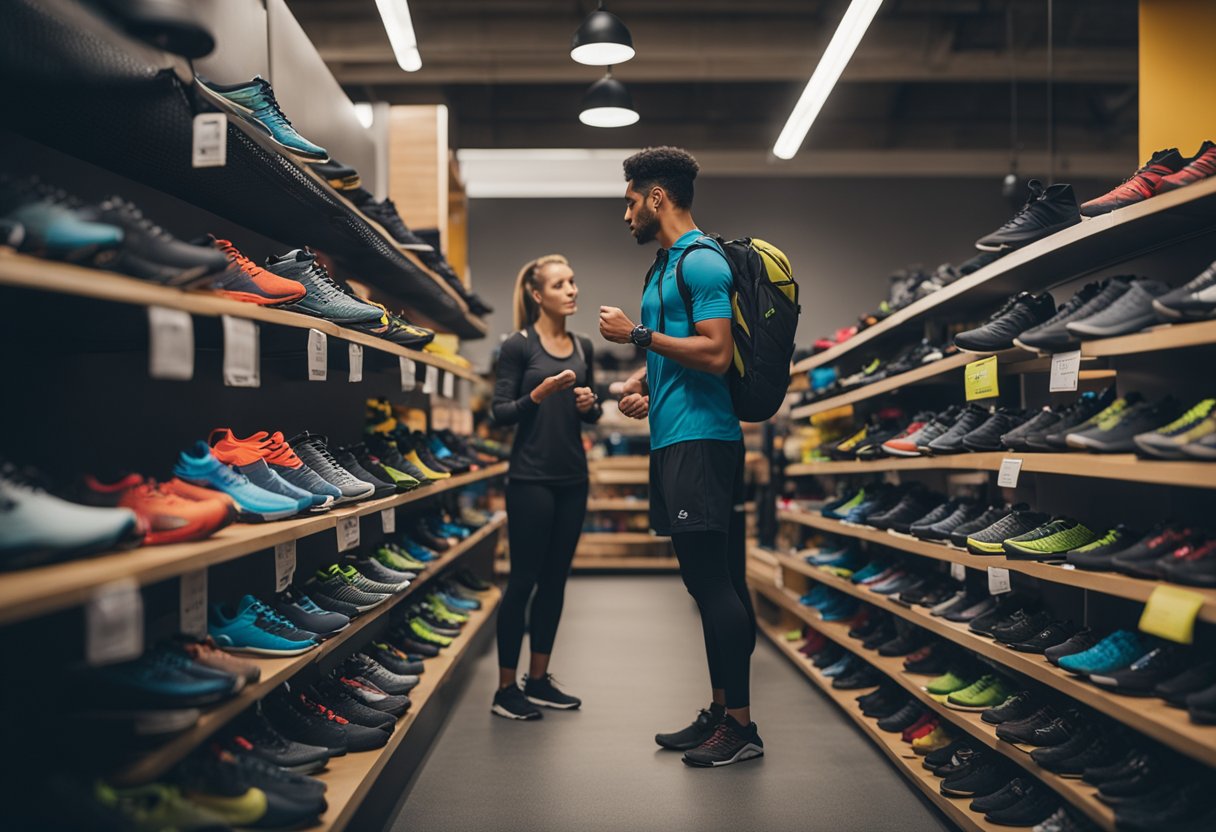
Don’t forget, trail running provides a sense of connection with nature that can be deeply rewarding. So, invite a friend, enjoy the shared benefits of the outdoors, and always remember the importance of leaving the trails as pristine as you found them.
Happy trails!

